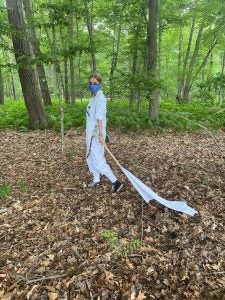The spread of Amblyomma americanum into southern Rhode Island yards
Abstract:
Rhode Islanders, along with residents of other northeastern states, are increasingly encountering Amblyomma americanum, the lone star tick. Lone star ticks, originally found in the southern tier of the U.S., may become a new risk and public health burden to Rhode Island communities. Prevention efforts can be most effective by knowing where different types of ticks are encountered. Data was gathered from 2017 to 2020 by collecting ticks in yards of residential southern Rhode Island. Yards were split into three zones in 2017 to 2019: the open lawn, the ornamental plants, and the forested area of the yard. Two zones were added in 2020: the lawn ecotone, and the forest edge. Data showed that lone star numbers increased each year in the yards. The number of yards containing lone star ticks also increased over the four years of the study. Lone star ticks seemed to reside in zones by the same trend as Ixodes scapularis, commonly known as the deer tick. They were found very little in the ornamental zone, moderately in the lawn zone, and highly in the forested zone. Further research should be conducted in order to accurately assess the habitat preferences of the lone star.
 Home
Home Browse
Browse Close
Close Events
Events Maps
Maps Email
Email Brightspace
Brightspace eCampus
eCampus




